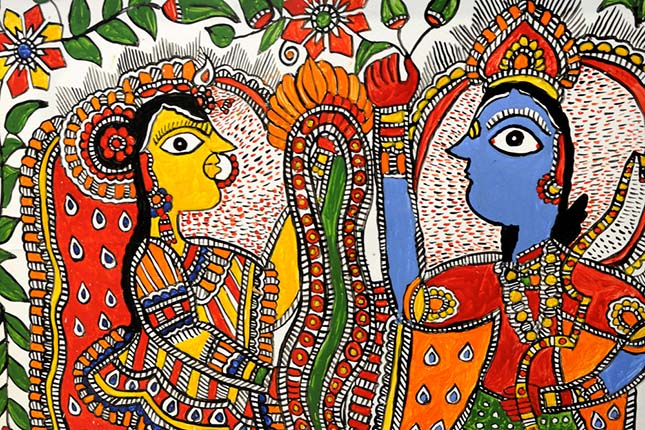Indian Folk Art And Paintings
Indian Folk Art
India’s folk art is very ancient and passed from one generation to another. Still, these old art forms are practised in various places in India. They became a part of Indian tradition and culture. During the period of Indian art, many art forms were advanced, and some vanished. However, the ancient folk art forms modified in colours and styles and still survive in society with their unique structure. The artists adopted the themes of art from epics, God and Goddesses. In the olden days, the artists used natural colours, mud, charcoal and leaves. They painted on canvas and cloth to bring antiquity to the art. Here is a brief description of 10 folk painting styles…
Madhubani Art

This art is also famous as Mithila art. Once, Mithila was the capital city of the Janaka kingdom in Bihar. This art form is in geometric patterns, and primarily women practised this art. The art form was mainly decorated on the huts’ walls in ancient times. For many years this art was under the shadow. But the British discovered Madhubani paint after an earthquake in 1930. Then the British found the walls of the broken houses with beautiful Madhubani paintings. Most of these art forms are in Mural shape with the subject of flora and fauna and God figures.
Miniature Paintings
The art objects are painted in small sizes with great expressions. These art forms are influenced by the Persian art style and flourished during the Mughal era. Jahangir and Shah Jahan mainly patronised to evolute this art throughout their kingdom. The Rajasthani artists were well impressed and adopted the art form into their native art. In this art, the artist mainly painted humans and war incidents; the eyes were painted broadly, as the pointed nose and shin waist. In these paintings, men always wore turbans.
Phat Art
This is the traditional art form of Rajasthan. Phat artists paint the religious forms of folk deities Pabujai and devnarayan. These paintings are large and use fifteen feet high canvas or cloth. The artists used natural vegetable colours and characterised the heroic deeds of the deities.
Warli
This is one of the ancient art forms of India. In 2500 B.C., the warli tribal people used these art patrons for decorations. The patterns are in the form of circles, triangles and squares. The art’s main subjects are hunting, fishing, festival celebrations, dancing and much more. The themes of the canvas are in red and black colours, and the objects are in white.
Gond
The art origin place was Madhya Pradesh. The Gondi tribal people created this art. The artists use bright, vibrant colours, and the objects are Flora and Fauna. The colours are prepared with coloured soil, cow dung and charcoal. The present artists adopted this style of dots and lines and implemented current art forms. This art form was introduced by the famous Gond artist Jangarh Singh Shyam in the 1960s.
Kalamkari
Kalamkari means ‘drawing with pen’. This art is very famous in machilipatnam and Srikalahasti in Andhra Pradesh. The colours are prepared naturally with leaves, vegetables and other natural sources. The artists used one type of pen to bring unique pictures. Kalamkari artmaking follows two different types. In Machilipatnam, most of the artists mind a block-printed style. Sri Kalahasti artists are pursuing the art of drawing with pen on fabric. The art objects are flora and fauna. In Srikalahasti, the artists adopt themes from epic events.
Tanjore Painting
Tanjore art originated during the 16 and 17th centuries. The Thanjavur Nayakas were patronaged to flourish this art form. The paintings made on wooden planks depict devotion to Gods and Goddesses. The art form is a combination of Maratha, Deccan and European styles.
Cheriyal Scrolls
This is an old art form, and the Nakashi family in Telangana only practises this art. The art form has been passed from one generation to another. Kalamkari influenced this Cheriyal scroll’s art. The Artists used primary colours. The scrolls are nearly 50 feet long and depict Puranas and epics.
Kalighat Paintings
This painting style originated in the 19th century at Kalighat, Bengal. At first, the artists adopted the themes from Hindu Epics. Later the artists concentrated on social reform subjects. They use squirrel hair brushes to apply the colours. The artists used cheap paper and colour pigments. The purpose of the paintings is to raise awareness about social conditions.